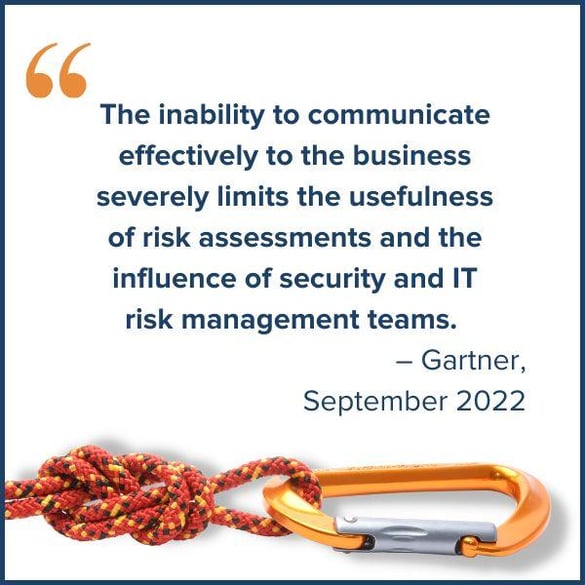
Trust is inseparable from risk, just as IT security is linked to business value.
The relationship between risk and trust is about balance. Risk management keeps the hackers at bay, so stakeholders remain confident in their investments. But businesses need help maintaining constant vigilance with evolving offensive and defensive cybersecurity tactics to protect their organizations.
TRUST IS EARNED
Blind trust has no place in any business model, but when IT security is on the line, a healthy dose of skepticism is good. What may have started as a handshake deal between a business and a service provider must develop into a high-trust relationship where both partners provide IT protection for the business. Actual risk mitigation means that your suppliers, vendors, partners, employees, and customers are aware of risks and actively participate in risk mitigation processes.
Risk and IT security are inextricably linked to business revenue by the nature of the business’s dependencies on the network, devices, public and private clouds, communications, and systems that power productivity. Each point of contact is an opportunity for criminals to interfere, so every point of contact must detect, identify, and defend against threats.
Security is everyone’s responsibility and requires constant vigilance. Share the burden of security by partnering with an IT Solutions Provider that is hyper-aware and responsive to your needs. Augment your IT team with IT service professionals with deep security protection and threat remediation expertise to better protect your bottom line.
So how do you build trust within your business and with your IT Solutions Provider to create a secure IT environment?
1. Communicate with transparency
2. Be purposeful in your actions
3. Keep security top of mind
4. Agree on your risk tolerance
5. Expect reliability
6. Be responsive
7. Nurture a culture of security
Take the time to discuss pain points with your IT Service Provider that go beyond the technical security tools—discuss how the people, processes, and office culture work. Then integrate a security program that nurtures trust within the company to protect your assets.
KNOW YOUR SECURITY POSTURE
If you are uncertain about your security posture, now is an excellent time to conduct a Security Posture Assessment (SPA) before investing in more security tools or staff. A Security Posture Assessment is an in-depth discovery of how your people, processes, and technologies work together to protect your organization. A SPA will find your vulnerabilities, inefficient processes, misconfigurations, missed updates and patches, unsecured endpoints, and space junk lurking in your systems. You will get a conclusive report on your risk status and a roadmap for reaching security maturity.
 |
Your SPA report will help you quantify your overall risk and provide an action plan to address critical discrepancies and a step-by-step roadmap to tackle less significant vulnerabilities in time. The SPA report is pivotal to jumpstarting open and frank discussions between leadership and your IT and business teams. The SPA's real value is initiating conversations to gain alignment within the organization to agree on actionable items. The report alone is not enough to fix your issues.
An IT Solutions Provider can help you fill the vulnerability gaps found in the discovery and prioritize a remediation strategy for your business's most significant financial and operational protection. With 24/7/365 monitoring, an IT service partner can safeguard your business operations and buffer threats with comprehensive cybersecurity solutions like Extended Threat Detection and Response (xTDR), Security Awareness training, and Data Backup and Disaster Recovery services.
IT SECURITY & COMPLIANCE
But the path to security maturity is not straight and narrow, nor is it for the weak of spirit! Protecting your business and data is a herculean task as you battle constant internal and external threats. It would serve you well to be agile, responsive, and decisive. Surround yourself with people you trust and who share the same security mindset.
You can leverage the NIST framework as a guide to structure your own best practices, best infrastructure design, and best risk management processes. Still, you also need to integrate your business intelligence and compliance standards into your security strategy. If this seems like a lot to do in a crisis management timeline, you're right!
To build customer confidence and promote stakeholder trust, seek qualified security architects and engineers with the depth of experience in your industry to help you meet and exceed compliance standards. Your IT security strategy should be stable yet flexible and able to adapt to the changing needs of your business and external disruption.
While a SPA can help quantify your overall risk, it cannot build trust. But a properly implemented security strategy, constant vigilance, reliability, and transparent communication can help your stakeholders balance risk and trust to support your organization.
You can recover from a security breach. But it is nearly impossible to recover from a loss of trust, which has immediate and severe consequences on your business value.
TRUST IS OUR DIFFERENTIATOR
At TBC, trust is our differentiator.
As an IT Solutions Provider that provides end-to-end security, network, infrastructure, data protection, and communication solutions across the globe, we understand the balance between risk and trust. We make risk management measurable for our partners and work to move our clients beyond the baselines of compliance and industry regulations to promote growth cycles in competitive industries.
We see your business as a whole entity—where your IT infrastructure and cybersecurity programs are cross-functional entities that support a future-forward growth trajectory. We can help you manage your risk and build confidence in your security strategy. TBC has a 95% client retention rate because we build trust from the beginning of our partnership journey with our clients.
.png)


